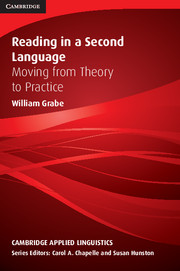III - DEVELOPING READING COMPREHENSION ABILITIES
Published online by Cambridge University Press: 05 August 2012
Summary
Part III examines in detail the major components of reading that combine to build reading comprehension abilities. These components include (a) syntactic knowledge and processing skills; (b) reading strategies that support comprehension; (c) the integration of reading strategies and higher-level processing to develop the strategic reader; (d) the role of discourse knowledge; and (e) the centrality of vocabulary knowledge. Part I identified component cognitive skills that combine to form reading abilities; these included several skills and resources that either were not solely intended to support reading comprehension (e.g., goal setting, inferencing, working memory) or that directly influenced reading comprehension only at certain stages of development (and less directly at other stages) (e.g., phonological awareness, word-recognition efficiency). In contrast, the specific topics discussed in Part III all strongly influence reading comprehension and are central topics for reading instruction.
The major shift in this part is in the nature of the skills and knowledge resources that form the core of reading-comprehension development – words, grammar, discourse, and strategies – and the integration of these abilities to produce the strategic reader, capable of understanding and using academic texts. Moreover, each of the skills and knowledge resources discussed in Part III is readily teachable. As a result, a major focus of each chapter is to examine what research tells us about effective teaching practices that develop each skill and that improve reading comprehension.
Chapter 10 addresses the most fundamental goal for L2 students: developing main-idea reading comprehension. Whether students are reading a brief two-paragraph text, a two-page text, or a 20-page chapter, they must be able to recognize the main ideas of the text.
- Type
- Chapter
- Information
- Reading in a Second LanguageMoving from Theory to Practice, pp. 195 - 197Publisher: Cambridge University PressPrint publication year: 2008



